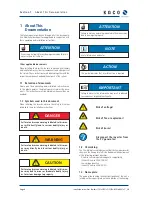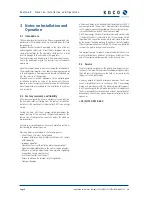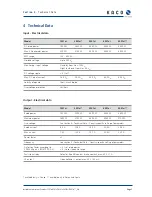
Operating Instructions Powador 1501xi/2501xi*/3501xi/4501xi/5001xi**
Page 7
4.2 LED displays
During normal operation, the photovoltaic modules generate
voltage as soon as there is suffi cient insolation. If this voltage
is present in the inverter at a certain level for a certain time,
the inverter begins feeding into the grid.
The inverter is equipped with three LEDs, which give informa-
tion about the various operating states as follows.
Figure 4.2:
LED displays
LED (1) (green):
The LED begins to light up starting from a photovoltaic module
voltage of approx. 100 V and goes out again if the module volt-
age is lower than 80 V.
LED (1) indicates that the inverter and the inverter control system
are active. If this LED is not lit, the inverter cannot feed into
the grid. In normal mode, the LED begins to light up in the
morning (if there is suffi cient sunlight) and goes out as nightfall
approaches.
LED (2) (green):
The LED always lights up when the inverter is feeding into the
grid. For this to happen, the photovoltaic module voltage must
exceed 125 V for a country-specifi c time period (see Installation
Instructions, section 4, Technical Data) and suffi cient power
must be provided by the PV generator. LED (2) can, therefore,
only light up when LED (1) is already lit.
In normal operating mode, the inverter begins feeding into
the grid in the morning and stops feeding into the grid as it
increasingly becomes darker. On cloudy days and in the winter
months, the grid feed can – depending on the PV generator
and the current grid feed power – be temporarily interrupted
and subsequently re-started. This process can repeat itself sev-
eral times, especially in the morning and evening. This is not a
sign of faulty operation. It is normal operating behaviour.
LED (3) (red):
The LED indicates that the grid feed was stopped due to a
fault.
The following faults activate LED (3):
Line overvoltage or undervoltage
–
Faulty line impedance or line frequency
–
Generator voltage is too high
–
Generator power is too high
–
Shutdown due to the temperature being too high
–
Fault in the unit
–
Wait approx. 10 minutes to see if the fault is only temporary
in nature. If this is not the case, notify your authorised electri-
cian.
If the fault is cleared, the grid feed begins once again after
a country-specifi c time period (see Installation Instructions,
section 4, Technical Data).
Check whether the fault in question relates to a general power
failure or whether the fuse between the meter and the inverter
has blown. If the fuse has blown, notify your authorised techni-
cian. If there was a power failure, simply wait until the fault has
been cleared. The system automatically re-starts.
4.3 Keys “1” and “2”
Figure 4.3:
Powador control keys
Key “1” is used to switch between the various displays for
measured values and data. Key “2” is used to make settings,
such as those relating to the date and time. Here, menu
navigation is divided into two levels. In level 1 (display mode),
measured values such as the solar generator voltage can be
read. Here, only key “1” is activated. In level 2 (confi guration
mode), key “1” is also used to navigate through the individual
displays, and settings are confi gured with key “2”.
S e c t i o n 4 ·
O p e r a t i o n
1
2
3
!
ok
IMPORTANT
If the grid feed phase fails (power failure on the public grid),
LED (3) does not light up. If this happens, all LEDs and the
display go out. The inverter is shut down completely. The
inverter cannot resume its normal operation until the grid
feed phase is available once again.
ACTION
By pressing key “1” for approx. 1 second, you can choose
which measured value is to be displayed. The menus are
continuous, which means that when you arrive at the last
entry in a menu, the fi rst entry is displayed once again the
next time key “1” is pressed (see fi gure 4.4).







































